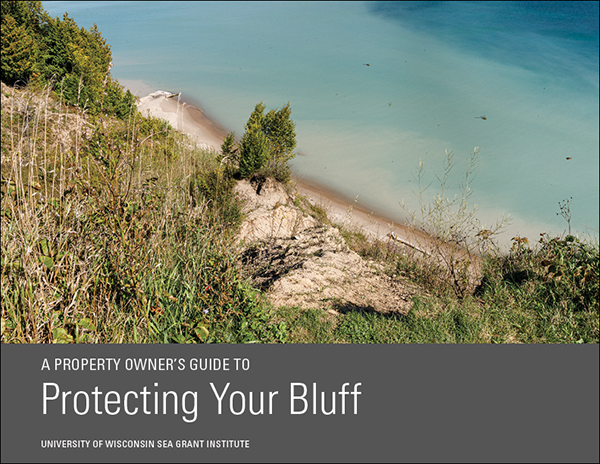
A top-down approach guide that explains practices property owners can implement to take care of their bluffs.
A Property Owner’s Guide to Protecting Your Bluff
Overview
This guide explains practices that property owners can use to take care of their bluffs, including informed site usage, proper water drainage, stabilizing vegetation, and if necessary, bluff toe protection.
Download A Property Owner’s Guide to Protecting Your Bluff here
The guide is structured with a “top-down” approach, starting with the bluff top where homes and infrastructure are often located, down to the water line where bluffs interact with the lake. Chapters in this guide include:
Chapter 1: Introduction
Describes the processes which affect bluff erosion.
Chapter 2: Bluff Top Management
Describes the obvious signs of bluff stability problems that may be present at the bluff top and a number of bluff-top practices to promote bluff stability through managing land use, surface water runoff, groundwater infiltration and vegetation.
Chapter 3: Bluff Face and Toe Management
Describes the obvious signs of bluff stability problems that may be present at the bluff face and toe and a number of practices to promote bluff stability through managing land use, surface water runoff, groundwater infiltration and vegetation. If there are major bluff stability problems that threaten a home, some combination of bluff regrading and toe protection may need to be considered to stabilize the bluff.
Appendix A: Selecting Suitable Vegetation for Enhancing Lake Michigan Coastal Bluff Stability in Southeastern Wisconsin
Lists and describes native species that are generally suitable for Lake Michigan bluffs in southeastern Wisconsin. Many listed species may also be applicable outside this region.
Appendix B: When Your Home Is at Imminent Risk From Bluff Failure
Appendix C: Special Considerations for New Construction
Other Products
A number of other resources have be developed during the production of this guide, including:
Coastal Hazards, Adaptation Options, and Educational Resources
A presentation which describes the “top-down” approach to protecting coastal properties feature in the guide.
When Your Home Is At Imminent Risk To Bluff Failure
This fact sheet will help homeowners understand when their homes are at imminent risk of bluff failure, what to do about it, and where to get more information.
Relocating Buildings Threatened by Great Lakes Erosion and Bluff Failure
This blog post describes the process of relocating at-risk buildings away from failing bluffs and includes a case study from Sheboygan County, WI.
Other Related Resources
Adapting to a Changing Coast – Options and Resources for Lake Michigan Property Owners – Publication with 16 options across 5 themes to help coastal property owners adapt to changing water levels and storms on Lake Michigan
Adapting to a Changing Coast – Options and Resources for Local Officials in Southeastern Wisconsin Coastal Communities – Publication with 28 options across 4 themes to help local government officials address changing water levels and storms on Lake Michigan
Living on the Coast – Booklet describing natural coastal processes and strategies to manage risk to coastal properties
Placing Erosion Control Structures on Great Lakes – Website with information on requirements and considerations for shore protection projects in Wisconsin
Stabilizing Coastal Slopes on the Great Lakes – Fact sheet describing shoreline erosion and slope instability
Working with Engineers and Contractors on Shore Protection Projects – Fact sheet describing the process of finding and working with qualified coastal professional
Great Lakes Shore Protections Structures and Their Effects on Coastal Processes – Fact sheet describing shore protection structures and their effects, both positive and negative, on the shoreline





